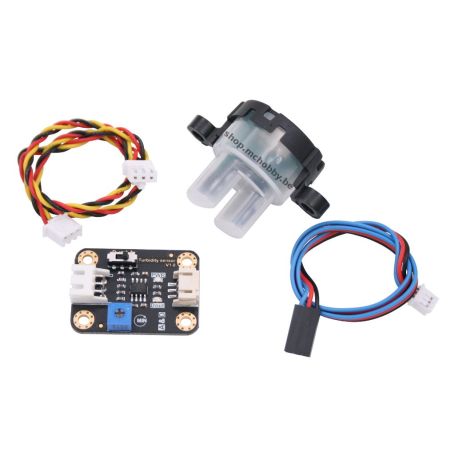Gravity: Analog Turbidity Sensor For Arduino
Gravity : Turbidity measurement - Turbidimeter
- Measurement of bodies suspended in a liquid
- Analog output : 0 to 4.5V
- Power supply : 5V
Payments are secured by LyraCollect, a French payment collection company.
It is possible to delivered to your home, to a pick-up point or picked up by appointment at MCHobby
We prepare, pack and ship your orders with great respect and care.
Turbidity sensor, detect the cleanliness of the water by measuring the quantity of suspended particles
The turbidity sensor is used to measure the level of particles in the water, a direct indicator of its cleanliness. Low turbidity water is relatively clean, this doesn't mean that it is drinkable!
This sensor therefore returns the turbidity level of the water by measuring the transmission of light in the water and the diffraction rate. These characteristics change with the amount of suspended solids in the water (Total Suspended Solids or TSS). When the TTS increases then the level of turbidity increases.
The most common use of this type of sensor is the measurement of turbidity of watercourse (rivers), waste water or pollution, research on sediment transport, laboratory measurements amount of algae in suspension in the water.
The turbidity sensor has an analog output (5V) or digital output (5V). The operating mode (analog/digital) can be chosen according to the microcontroller available (some have no analog input). The digital output activation threshold is adjustable.
Being a 5V sensor with analog output, it is ideal for the Arduino Uno range. It is nevertheless possible to use it with 3.3V microcontrollers using a voltage divider bridge.
Please note: the turbidity sensor is not waterproof, so it cannot be completely immersed in the liquid.
Use at 3.3V: this sensor has an analog output with a voltage between 0 and 4.5V. It is possible to use this sensor on a 3.3V system using a 1/3 + 2/3 voltage divider bridge (5K Ohms and 10K Ohms). By measuring the voltage across the 10K resistor, it will remain below 3.3V.
Technical details
- Operating Voltage: 5V DC
- Operating Current: 40mA (MAX)
- Response Time: <500ms
- Insulation Resistance: 100M (Min)
- Output Method: Analog
- Analog output: 0-4.5V
- Digital Output: High/Low level signal (you can adjust the threshold value by adjusting the potentiometer)
- Operating Temperature: 5°C à 90°C
- Storage Temperature: -10°C à 90°C
- Weight: 30 gr
- Adapter Dimensions: 38mm * 28mm * 10mm
Content
For each order, you will receive the turbidity sensor, the interface board, a gravity analog cable and a cable to bind the sensor and interface board togheter.
Tutorial
- Turbidity sensor (DFRobot, English)





